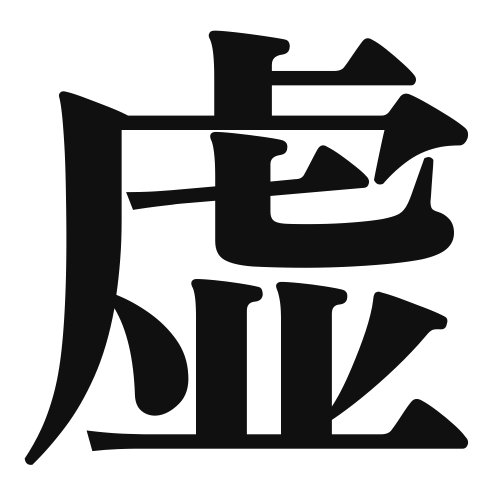1. Overview of Meaning
The kanji “虚” (kyo) generally means “empty,” “void,” or “false.” It conveys a sense of emptiness or lack, often used in contexts that imply something is not genuine or is lacking substance.
2. Formation and Radical
Formation of the Kanji: The kanji “虚” is a compound character (会意文字) that combines elements to convey its meaning. It consists of the radical “亻” (person) on the left, which often relates to human actions or characteristics, and “虍” (tiger) on the right, which can symbolize fierceness or strength. Together, they suggest a concept of emptiness related to human experience.
Radical: The radical of “虚” is “亻,” which is associated with human-related actions or attributes.
3. Examples of Usage
Common Words and Phrases: Some frequently used words that include “虚” are:
- 虚無 (kyomu) – emptiness, void
- 虚偽 (kyogi) – falsehood, deception
Example Sentences in Daily Conversation:
- この部屋は虚無感がある。 (Kono heya wa kyomu kan ga aru.) – This room has a sense of emptiness.
- 彼の言葉は虚偽だった。 (Kare no kotoba wa kyogi datta.) – His words were falsehoods.
4. Synonyms and Antonyms
Similar Kanji: A kanji with a similar meaning is “空” (sora), which also means “empty” or “sky.” However, “空” often refers to physical emptiness or the sky, while “虚” has a more abstract connotation of emptiness or lack of substance.
Antonyms: A kanji that represents the opposite meaning is “実” (jitsu), which means “truth” or “reality.” It conveys a sense of fullness or authenticity, contrasting with the emptiness implied by “虚.”
5. Cultural and Historical Background
Relation to Japanese Culture: The concept of “虚” is significant in Japanese culture, often associated with Zen philosophy, which emphasizes the importance of emptiness and the void in understanding existence.
Proverbs and Idioms: One common saying is “虚を実にする” (kyo o jitsu ni suru), which means “to turn the void into reality,” highlighting the transformative power of understanding emptiness.
